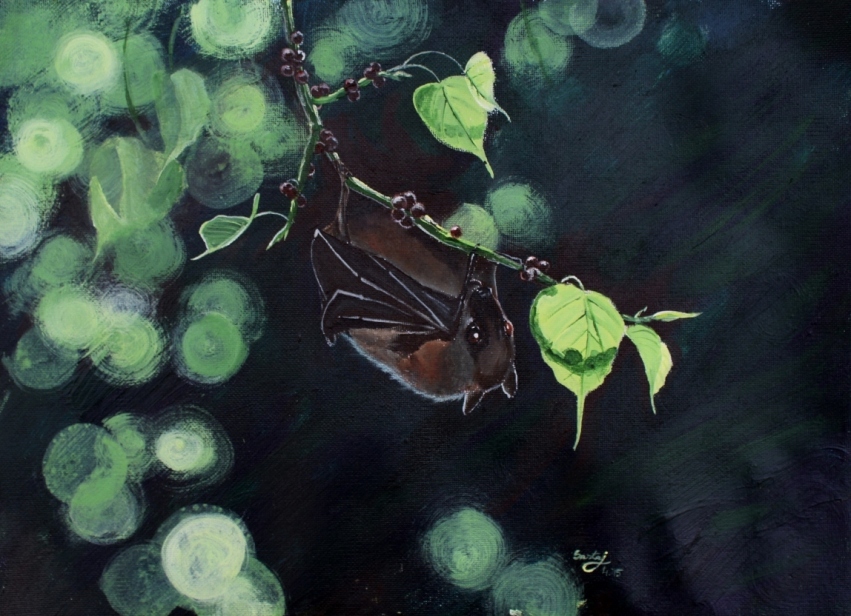
Sartaj Ghuman is a mutli-faceted artist – a painter and a poet who prefers poetry to academics. Hailing from Batala, Punjab, he is a trained wildlife biologist who has worked on animal cognition and communication with Dr. Anindya Sinha and Dr. Rajesh Kasturirangan at NIAS, Bengaluru. Learn about the versatile Sartaj Ghuman’s life, art, and conservation initiatives in his own words.
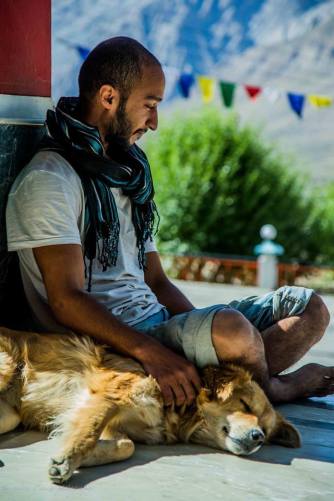 I grew up in the urban spaces of Batala, Punjab. My childhood experiences were always associated with nature and environment. Encouraged by my parents I grew up with dogs, gardens, and with a wonder for the living world. I remember spending long afternoons in our garden watching the garden lizards, the squirrels, or looking for spiders amongst the plants. Weekends would often be spent at a nearby canal or at some non-urban, non-cultivated place. This very interest in nature later led me to get trained in wildlife studies
I grew up in the urban spaces of Batala, Punjab. My childhood experiences were always associated with nature and environment. Encouraged by my parents I grew up with dogs, gardens, and with a wonder for the living world. I remember spending long afternoons in our garden watching the garden lizards, the squirrels, or looking for spiders amongst the plants. Weekends would often be spent at a nearby canal or at some non-urban, non-cultivated place. This very interest in nature later led me to get trained in wildlife studies
I remember once when in Class IX, studying at a Delhi school, I got stuck while narrating a Punjabi folktale about ‘gtar’ (myna in Punjabi) and peacock, for want of the English name. During that class vacation, I found one of my Dad’s books about birds and their common names in English. And before I knew it, I was busy bird-watching. The tree-watching with the help of Pradip Krishen’s Trees of Delhi was just a logical next step.
As I went back to nature and nature-watching, time and again, it was more of a pick through elimination rather than a real choice to become a wildlife biologist. Growing up I knew I wanted to be outdoors, so I began to look for possibilities beyond office jobs. Though medicine and engineering were the only two viable career options that my parents came up with at the time, I had already been leaning towards “environmental” engineering, though not really knowing what it involved; I was keen as long as it had ‘environment’ in the name. Eventually when I heard of WII, the Wildlife Institute of India, and their course in Wildlife Science, my heart was set.
I immensely enjoyed spending time in the field. I worked on the nature of communication, an area that continues to intrigue me. However, during my stint at National Institute of Advanced Studies (NIAS), I realized that academics was not where I wanted to be. So five years ago, I left academics and stopped getting actively involved in any research.
Leaving the academics allowed me the time to spend on painting and sketching that I had always loved, though it is only more recently that I have begun to consider myself as an artist. I never had any formal training in art apart from the weekly art class at school. At home, I always dabbled in a large drawing book that my mother would get specially bound for me. Just like bird-watching and bouldering, or almost anything else for that matter, the more time one spends on something, one gets better at it. Same thing happened with my painting. More the time I spent painting, the better I got at it. The better I got at it, the more I got hooked, and ended up spending more time doing it; and so it goes.
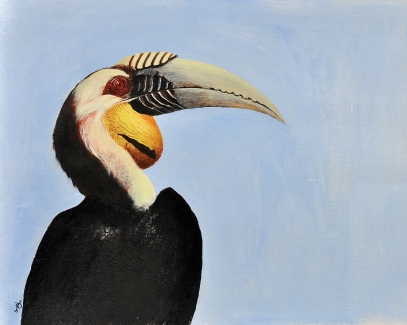
I paint things I like, mostly mountain landscapes, people who inspire me, and birds! I paint things as I see them, not photo-realistic though. To me painting is as much about the subject and the end product, as the process itself. Through painting I am learning how to recreate colours, textures, and the proportions that I see in nature. I use acrylic on canvas or plywood. I had my first solo exhibition last year.
I have made illustrations for articles about ecology and conservation (an especially memorable contribution was for an article by Rohit Naniwadekar in the magazine saveus, about his PhD research; he invited me to make paintings to accompany his article rather than send in photographs!), painted at interpretation centres and have done illustrations for books. Recently, M. O. Anand, a great friend and a brilliant ecologist, asked if I could help translate his research into an easily accessible poster, something that could be understood directly and easily by the stakeholders. His work was about the benefits of the proximity of sacred groves to and their importance for coffee plantations. My work on that poster can be seen here.
I have painted some school walls, so that children become familiar with the birds they see around them. Aldo Leopold once said, when it came to the crunch, we’d save what we love, and we love what we know and understand. So through art I try to educate the school kids about the birds and the trees around them.
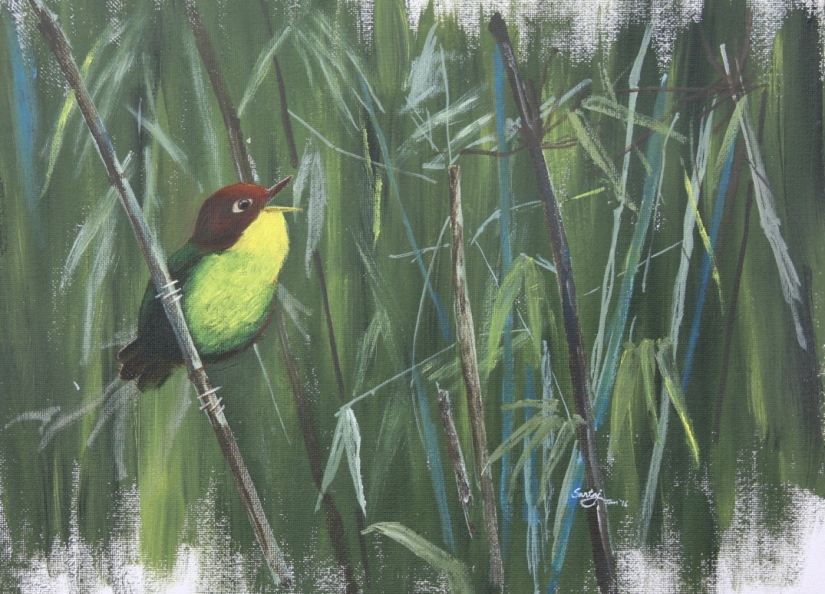
The only time I have really engaged directly with any community through my art was last year 2016 in north Sikkim, where I stayed and painted for about three months. Apart from the beautiful landscapes and the birds, I painted the dying lifestyles – people working in fields, tending to their cows, the field-houses. And to my distress I found them shy, almost embarrassed by the fact that they grow their own food and lead an independent, self-sufficient life – the very aspect of their lifestyle that ought to have made them proud of themselves.
Over the years, my views on conservation have evolved from an initial, rather simplistic one. Now, it means more than wildlife conservation to me, that conservation is more a lifestyle that allows us to live in harmony with nature. In a increasing bid to emulate what is seen as a ‘developed’ or ‘advanced’ way of life, people everywhere are neglecting functionality and are going in for a hollow makeover that leaves them stranded. I see it in the concrete and glass facades of the buildings in urban Punjab that neglect the drainage or waste management. I see it in the neglect of the moral code of the hunter-gatherer of the past, in a bid to make quick money in some not-so-remote parts of the north-east; and in the slow surrender of self-sufficient independence through a shift to purchasing things that are now easily available but were once pain-painstakingly made at home in the remote mountains of the western Himalayas.
“Let he who has never sinned cast the first stone” said Jesus when asked what should be done with the adulteress, and the mob melted away. I find myself in a similar predicament when arguing for conservation of wildlife, or for protection of forests with those who live in or around places that still have nature intact. Conservation, like philosophy, has to be demonstrated through one’s deeds, through one’s own lifestyle before one can stand up for it amongst the people.
My current life lesson, the one I am still coming to terms with at this moment, is that all that is romantic, or beautiful, is tough; and all that is easy, is corrupting. It reminds me of what Dr. Anindya ‘Rana’ Sinha, my mentor, specialist in primate behaviour, would often tell us – about the harmful effects of feeding roadside monkeys. Easily available, abundant, hand-fed food was a root cause of many ills – increased mortality or road-kills, increased aggressive interactions instead of cooperation amongst the monkeys, hierarchy which would have prevented feuds from transforming into violence, was now disrupted leading to group fission. Thus, easy food by the roadside literally turns the monkeys’ world upside down. As I write about conservation and life I have learnt one important, humbling lesson that everything is dispensable; the stronger you are, the more you can dispense with. Living minimally simply enhances and enriches our living.
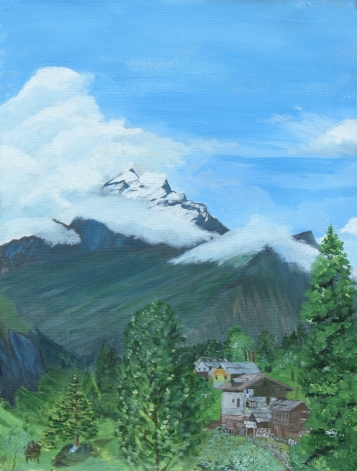
After quitting academics Sartaj has assisted researchers in the field on projects about bird ecology, plant ecology, rodent biogeography, and the socio-economics of rural communities that live alongside endangered fauna. He loves the mountains, and finds reasons to spend more and more time in the Himalayas, and now, for the last two years, has been assisting on a glaciology project in his capacity as a mountaineer. He recently finished a mountaineering course. Sartaj loves cycling too, whenever he can find time for it.
Proud of u Sartaj .
LikeLike
Beautiful, sincere work. What a life you have led !!
LikeLike
So encouraging! The fact that someone leads a life of his/her passions is simply inspiring.
LikeLike